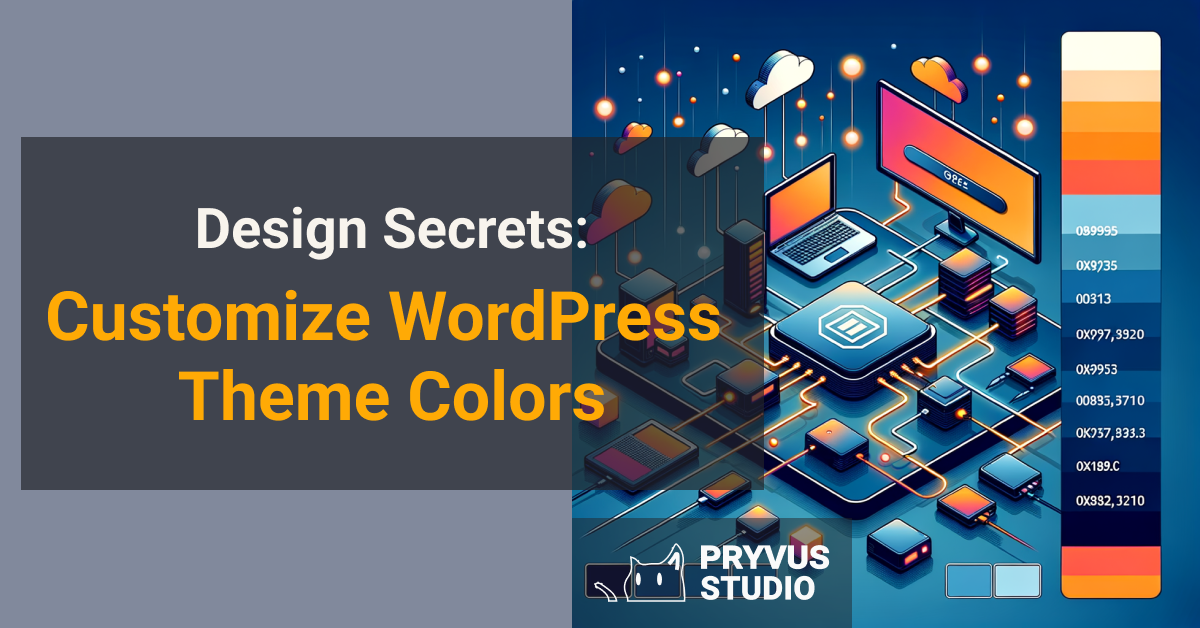Notice: Only variables should be passed by reference in /home/ploi/pryvus.com/public/wp-content/themes/pryvus/template-parts/content-post.php on line 12

Understanding the impact of color in WordPress theme customization is crucial.
This article explores how color choices affect your website’s overall effectiveness, from conveying your brand’s identity to enhancing the user experience. It promises practical insights for anyone looking to make informed decisions about their website’s design.
In this article, you will learn:
- The psychological impact of color choices
- How to align color with your brand identity
- Testing colors for best user experience
Understanding the Impact of Color in WordPress Theme Customization
When it comes to customizing your WordPress theme, tweaking the colors is not just about aesthetics. It’s about communicating your brand’s identity, enhancing user experience, and even improving conversion rates. Colors can evoke emotions, convey messages, and guide visitors through your site, making it crucial to choose the right palette.
The power of color in web design cannot be underestimated; it shapes user perception and behavior.
But, how do you start? First, understand the psychology of colors. Different colors can trigger various emotions. For example, blue conveys trust and security, often used by banks and social media platforms. Red, on the other hand, is energetic and can increase heart rate, commonly used for ‘Buy’ buttons to encourage clicks.
Next, consider your brand identity. Your website’s color scheme should align with your brand’s colors to ensure consistency and recognition. If your brand is all about innovation and creativity, vibrant and bold colors might be the way to go. Conversely, if your brand prioritizes trust and reliability, softer, more conservative colors could be more appropriate.
Accessibility is another key factor. Not everyone sees color the same way, so it’s essential to choose a color scheme that is accessible to as many people as possible. This includes considering color contrast for readability and ensuring that information is not conveyed by color alone.
Pryvus Studio, with its focus on innovative solutions in web and mobile development, emphasizes the importance of color customization in achieving technical power to solve business challenges. Our experience shows that the right color scheme can streamline processes and unlock new opportunities for clients.
Finally, testing is crucial. What looks good on paper might not translate well on screen. Use A/B testing to try out different color schemes on your website and gather data on what works best for your audience.
Navigating the WordPress Customizer for Theme Color Changes
When it comes to personalizing your website, adjusting theme colors is a fundamental step. The WordPress Customizer, an integrated tool, simplifies this process, allowing for real-time previews. Let’s dive into how to make these changes effectively.
Mastering the WordPress Customizer is key to unlocking your site’s visual potential through color customization.

First, access the Customizer from your WordPress dashboard by navigating to Appearance > Customize. Here, you’ll find the ‘Colors’ or ‘Color Scheme’ section. This area varies based on your theme but generally allows for the adjustment of background, header, and link colors.
For more granular control, some themes include options for different elements like menus and widgets. If your theme supports it, you might even find presets that can instantly transform your site’s vibe.
However, not all themes offer extensive color customization in the Customizer. This is where plugins and CSS come into play, offering more flexibility. Plugins like ‘Theme Customization API’ enhance the Customizer’s capabilities, allowing for a wider range of adjustments.
Remember, while changing colors, it’s crucial to maintain visual harmony and readability. Use contrasting colors for text and background to ensure content is easily readable. Also, consider your brand’s color palette to maintain consistency across all platforms.
Finally, don’t forget to preview changes on different devices. This ensures your color adjustments look great on desktops, tablets, and smartphones alike. With these steps, you’re well on your way to a more personalized and engaging website.
Leveraging Plugins for Enhanced Color Customization
When it comes to customizing the colors of your WordPress theme, plugins offer a world of possibilities. These tools can take your site from standard to standout, offering more flexibility and creativity in color selection. Whether you’re looking to inject personality into your site or align it more closely with your brand, plugins can help you achieve your vision.
Plugins are key to unlocking the full potential of color customization in WordPress themes.
There are a multitude of plugins available, each with its unique features. Some focus on creating dynamic color palettes, while others offer advanced controls for tweaking every aspect of your sites design. Selecting the right plugin depends on your specific needs and the level of control you desire.
Popular Color Customization Plugins:
- Elementor – Known for its drag-and-drop interface, it allows for live color changes.
- Customify – Offers extensive options for site-wide color adjustments.
- YellowPencil – Provides a visual CSS style editor, perfect for hands-on customization.
Implementing plugins not only enhances the aesthetic appeal of your site but also contributes to a cohesive brand image. It’s essential, however, to maintain a balance. Over-customization can lead to a cluttered look or slow down your site. Therefore, it’s crucial to prioritize speed and user experience alongside visual appeal.
Moreover, understanding the basics of CSS can further refine your customization efforts. While plugins offer a great starting point, CSS allows for precise adjustments. This combination ensures that your site remains visually appealing, functional, and aligned with your brands ethos.
In conclusion, leveraging plugins for color customization is a powerful strategy for distinguishing your WordPress site. By carefully selecting and using these tools, you can enhance user experience, reinforce your brand identity, and ensure your site stands out in a crowded digital landscape.
The Role of CSS in Fine-Tuning Your Theme’s Colors
When it comes to customizing the colors of your WordPress theme, CSS plays a crucial role. It offers precision and control beyond what the WordPress Customizer and plugins provide. With CSS, you can fine-tune the colors of virtually any element on your site, from the font color to the background of individual sections.
Mastering CSS is key to unlocking unlimited color customization possibilities for your WordPress theme.

Understanding CSS selectors and properties is the first step towards using CSS for color customization. For example, changing the background color of your header could be as simple as identifying the header selector and applying a new background color property.
Here are some practical steps to get started:
- Identify the CSS selector for the element you want to change.
- Use the Chrome Developer Tools or a similar tool to experiment with color changes in real-time.
- Apply your changes by adding custom CSS in the WordPress Customizer or your child theme’s style.css file.
However, it’s important to maintain color consistency across your website. This not only enhances the visual appeal but also reinforces your brand identity. A cohesive color scheme can guide users through your site, improving navigation and the overall user experience.
Finally, while CSS offers great power in customization, it’s essential to use this power wisely. Over-customization can lead to a cluttered look and negatively impact site performance and user experience. Striking the right balance between customization and usability is key.
Maintaining Color Consistency Across Your Website
When you customize WordPress theme colors, keeping a consistent color scheme across your entire website is key. This consistency is not just about aesthetics; it impacts user experience, brand perception, and even conversion rates. Let’s dive into why color consistency matters and how you can achieve it.
Consistent color schemes enhance user experience and strengthen brand identity.
Firstly, establish a primary color palette. This palette should reflect your brand and be appealing to your target audience. Use it consistently across all web pages, including headers, footers, and buttons. This uniformity creates a cohesive look and feel.
Next, consider the emotional impact of your colors. Different colors can evoke different feelings and actions from users. Understanding color psychology can help you make informed decisions about your palette.
Utilizing tools like Adobe Color or Coolors can aid in selecting complementary colors. These tools ensure your chosen colors work well together, maintaining harmony across your site.
Implementing CSS is crucial for maintaining color consistency. With CSS, you can define specific color values for various elements, ensuring they remain consistent regardless of the page or section.
Finally, test your website on different devices and browsers. This ensures colors appear consistently across all user access points, providing a unified brand experience.
In conclusion, maintaining color consistency is essential for a professional, brand-aligned website. By carefully selecting a color palette, understanding color psychology, using color tools, implementing CSS, and testing across devices, you can achieve a visually cohesive site that enhances user experience and supports your branding efforts.
Unleashing Your Website’s Potential with Color Customization
Color customization in WordPress is more than just a touch-up; it’s a game-changer for your website. By carefully selecting and implementing the right color palette, you can significantly enhance your brand identity, improve user experience, and potentially increase conversion rates. But where do you start? Let’s break it down.
- Understand the psychology of colors: Each color evokes different emotions and reactions. Choosing the right colors can set the right mood for your website.
- Align colors with your brand identity: Ensure your color choices reflect your brands personality and message. Consistency is key.
- Ensure accessibility: Make your website welcoming to everyone by considering color contrast and readability.
- Test, test, test: Always preview changes and gather feedback to see how your color choices perform across different devices and user groups.
Remember, the goal is not just to make your site look pretty but to create a visually cohesive and functional space that resonates with your visitors. Pryvus Studio understands the transformative power of color customization. We’re here to help you unlock your website’s full potential. Ready to make your site stand out? Let’s chat.


